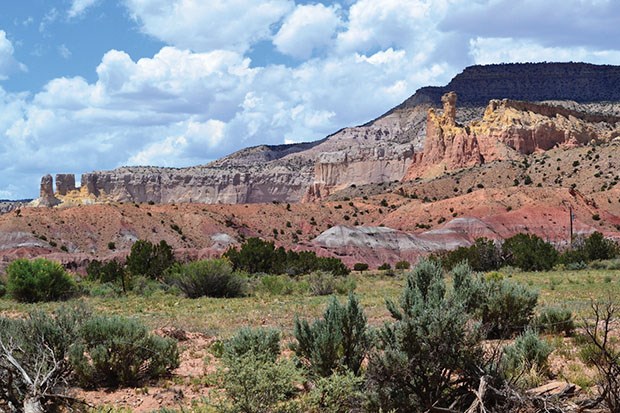Sante Fe is rich with murmurs from the ancient past and to hear them you only have to visit Tsankawi, an unexcavated site that forms part of Bandelier National Monument.
Here, once you've trekked up the dusty paths and slipped through the narrow channels of the hillside, you find yourself on a centuries-old path where the ancestral Pueblans once lived.
The stones that formed walls of their homes have long since surrendered to gravity. But as you step cautiously around those fallen walls you hear the crunch of pottery beneath your feet, shards that formed parts of their cups and bowls 600 years ago, and that still bear the smoothness of their careful sculpting, the decor of their precise hands.
I couldn't ask for a better guide than former archaeologist Janet McVickar, a guide with Adventure Partners at Four Seasons Rancho Encantado Resort in Santa Fe. She examines the shards that litter the path around us, pointing out hollows in the ground called kivas that were used for Pueblan religious ceremonies.
"This here must have been the midden," she says, gesturing towards an area where the soil is distinctly darker. "That's where they'd clean out the ash from their fires."
To the naked eye the high desert around Santa Fe doesn't hold out much hope for a hungry traveler. But those intimately familiar with this landscape know it's rich not just in archaeological ruins, but also in edible plants. The pinion juniper woodland contains pinion pines known for
their pine nuts, blue grass with nourishing, edible seeds and juniper berries, all of which formed part of the ancestral Pueblans' diet.
Twenty minutes' drive away, the visitor centre and gift shop at the larger Bandelier National Monument site receives thousands of visitors a year and is well excavated.
But the same is not true of the Tsankawi Ruin, where we find ourselves alone with the whistling wind on the two-kilometre trail.
We pass caves once inhabited by the Pueblans, their interior walls still bearing signs of plaster and their ceilings blackened by fire from food preparations that date back six centuries. There are mysterious petroglyphs on some of the rock faces and stair-like indentations that indicate how and where the nimble-footed Pueblan ancestors climbed this terrain as they moved between their hilltop homes and the grassy meadows of the valley below where they likely farmed.
It's a trail full of ancient history whose artifacts can be touched by visitors, which makes the experience much more immediate than that of touring the glass exhibits in a museum.
Perhaps it's the artists' influence or the energy fields around Santa Fe, but whatever the secret to the city's magic, its vast, open sky and timeless red-hued mountains tugs at many hearts.
One heart that clamoured loudly for Santa Fe belonged to Georgia O'Keeffe, one of the most lauded artists of the 20th century. To see why she fell in love with the landscape we head northwest towards Ghost Ranch, her home and inspiration from the 1940s until the '80s.
We hike into an area she called the White Place, one of her painting spots distinguished by its massive sediment hoodoos and columnar mountains that nature has lined up with almost military precision.
We walk through the dry valley, the shrill sound of cicadas in our ears and the dipping, diving whitethroated swifts our only companions. At peace in her own company, O'Keeffe found refuge in this landscape where shadows dance across the mountains and the rock colours range from whites to oranges, reds to browns.
On the 21,000-acre Ghost Ranch there are hiking and horseback trails and two small museums devoted to anthropology and paleontology. O'Keeffe's home on the ranch is not open to the public and another property she owned in nearby Abiquiu offers tours by appointment only, to limited numbers and with strict rules.
So visitors who want to learn more about O'Keeffe and what inspired her must content themselves with the impressive views and the vast, unlimited silence.
Not much has changed out here over the years, and were O'Keeffe's ghost to return, she'd likely be glad that murmurs from both the ancient and the more recent past still hang, almost audibly, in the New Mexico air. Travel Writers' Tales is an independent travel article syndicate that offers professionally written travel articles.



